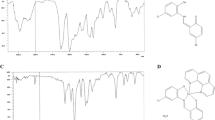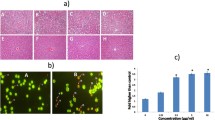Abstract
In the background that there is concerted effort to discover newer metal-based cancer chemotherapeutic agents that could overcome the limitations in cisplatin and that copper, a biocompatible and redox-active metal, offers potential as alternative to cisplatin, the present study was undertaken to investigate the in vitro anti-proliferative properties of the mononuclear copper(II)complex [Cu(L)(diimine)] + where LH = 2-[(2-dimethylaminoethylimino)methyl]phenol and diimine = dipyrido[3,2-a:2′,3′-c]phenazine (dppz) using breast cancer cell lines MCF-7 (ER+ve and p53WT) and MDA-MB-231(ER−ve and p53mutant) when cisplatin was used as positive control. The complex affected the viability of both the cell lines in dose—as well as duration-dependent manner as revealed in the MTT assay. The 24 and 48 h IC50 of the complex were several times lesser than those of cisplatin, and within this huge difference the efficacy of the complex was much superior with MCF-7 cell compared to MDA-MB-231 cell. The cell death was preferentially apoptosis, though necrosis also occurred to a certain extent. These inferences were substantiated by AO/EB fluorescent staining, Hoechst staining, assessment of mitochondrial transmembrane potential, comet assay for DNA damage, DCFH assay for reactive oxygen species (ROS) generation and Western blot of apoptosis–related proteins. Thus, the copper(II) dppz complex under investigation is much more efficient than cisplatin in affecting viability of the breast cancer cells. The underlying mechanism appears to be DNA damage-primed (in view of the known intercalation mode of binding of the complex with DNA) and ROS-associated mitochondria-mediated intrinsic apoptosis to a great extent but necrosis also has a role to a certain extent, which may also be a PARP-mediated cell death independent of apoptosis. Within the purview of this conclusion, the results indicate that the ER and/or p53 genotypes have a bearing on the efficacy of the complex as a cytotoxic agent since the response in the ER−ve and p53mutant MDA-MB-231 cell was not so prominent as in ER+ve and p53WT MCF-7 cell. Taken together, the complex has been shown to be a potential DNA damaging agent and, in the light of the superiority of the complex over cisplatin, we are further investigating the possibility of targeted nano-delivery of the complex to the tumor cells. When tested on a normal cell, 3T3, Cu(II)dppz was found to affect its viability but at concentrations very high compared to those for the breast cancer cells. Yet, this is a cause of concern and, therefore, we are working out a strategy for targeted delivery of this complex to the cancer cells only.












Similar content being viewed by others
References
Aggett PJ, FairweatherTait S (1998) Adaptation to high and low copper intakes: its relevance to estimated safe and adequate daily dietary intakes. Am J Clin Nutr 67:1061–1063
Anbu S, Shanmugaraju S, Ravishanker R, Karanda AA, Mukherjee PS (2012) Naphthylhydrazone based selective and sensitive chemosensors for Cu2+ and their application in bioimaging. Dalton Trans 41:13330–13337
Bruijnincx PC, Sadler PJ (2008) New trends for metal complexes with anticancer activity. CurrOpinChemBiol 12:197–206
Cheung-Ong K, Giaever G, Nislow C (2013) DNA-damaging agents in cancer chemotherapy: serendipity and chemical biology. Chem Biol 20:648–659
Christiana XZ, Stephen JL (2003) New metal complexes as potential therapeutics. CurrOpinChemBiol 7:481–489
Cory S, Adams JM (2002) The Bcl-2 family: regulators of the cellular life-or-death switch. Nat Rev Cancer 2:647–656
Crim JA, Petering HG (1967) The antitumor activity of Cu (II) KTS, the copper (II) chelate of 3-ethoxy-2-oxobutyraldehyde bis (thiosemicarbazone). Cancer Res 27:1278–1285
Elkholi R, Chipuk JE (2014) How do I kill thee? Let me count the ways: p53 regulates PARP-1 dependent necrosis. BioEssays 36:46–51
Haupt S, Berger M, Goldberg Z et al (2003) Apoptosis—the p53 network. J Cell Sci 116:4077–4085
Hofseth LJ, Hussain SP, Harris CC (2004) p53: 25 years after its discovery. Trends PharmacolSci 25:177–181
Holford J, Sharp SY, Murrer BA, Abrams M, Kelland LR (1998) In vitro circumvention of cisplatin resistance by the novel sterically hindered platinum complex AMD473. Br J Cancer 77:366–373
Jaividhya P, DhivyaR Akbarsha MA, Palaniandavar M (2012) Efficient DNA cleavage mediated by mononuclear mixed ligand copper (II) phenolate complexes: the role of co-ligand planarity on DNA binding and cleavage and anticancer activity. J InorgBiochem 114:94–105
Kelland L (2007) The resurgence of platinum-based cancer chemotherapy. Nat Rev Cancer 7:573–584
Kumar RS, Arunachalam S, Periasamy VS, Preethy CP, Riyasdeen A, Akbarsha MA (2008) Synthesis, DNA binding and antitumor activities of some novel polymer–cobalt (III) complexes containing 1, 10-phenanthroline ligand. Polyhedron 27:1111–1120
Labbe S, Thiele DJ (1999) Pipes and wiring: the regulation of copper uptake and distribution in yeast. Trends Microbiol 7:500–505
Latt SA, Stetten G, Juergens LA, Willard HF, Scher CD (1975) Recent developments in the detection of deoxyribonucleic acid synthesis by 33258 Hoechst fluorescence. J HistochemCytochem 23:493–505
Linder MC, Goode CA (1991) Biochemistry of Copper. Plenum Press, New York
Maity B, Roy M, Banik B, Majumdar R, Dighe RR, Chakravarty AR (2010) Ferrocene-promoted photoactivated DNA cleavage and anticancer activity of terpyridyl copper (II) phenanthroline complexes. Organometallics 29:3632–3641
Majeed W, Aslam B, Javed I, Khaliq T, Muhammad F, Ali A, Raza A (2014) Breast cancer: major risk factors and recent developments in treatment. Asian Pac J Cancer Prev 15:3353–3358
Michal P, Karol D, Agnieszka K (2013) Selected copper(I) complexes as potential anticancer agent. Chemik 67:1181–1190
Min KJ, Jung KJ, Kwon TK (2014) Carnosic acid induces apoptosis through reactive oxygen species-mediated endoplasmic reticulum stress induction in human renal carcinoma caki cells. J Cancer Prev 19:170
Miura T, Hori-I A, Mototani H, Takeuchi H (1999) Raman spectroscopic study on the copper (II) binding mode of prion octapeptide and its pH dependence. Biochemistry 38:11560–11569
Moller P, Knudsen LE, Loft S, Wallin H (2000) The comet assay as rapid test in biomonitoring occupational exposure to DNA-damaging agents and effect of confounding factors. Cancer Epidemiol Biomarkers Prevent 9:1005–1015
Montero J, Dutta C, Van Bodegom D, Weinstock D, Letai A (2013) p53 regulates a non-apoptotic death induced by ROS. Cell Death Differ 20:1465–1474
Mosmann T (1983) Rapid colorimetric assay for cellular growth and survival: application to proliferation and cytotoxicity assays. J Immunol Methods 65:55–63
Pattan SR, Pawar SB, Vetal SS, Gharate UD, Bhawar SB (2012) The scope of metal complexes in drug design – a review. Indian Drugs 49:5–12
Pulido MD, Parrish AR (2003) Metal-induced apoptosis: mechanisms. Mutat Res 533:227–241
Rajendiran V, Karthik R, Palaniandavar M, Stoeckli-Evans H, Periasamy VS, Akbarsha MA, Srinag BS, Krishnamurthy H (2007) Mixed-ligand copper (II)-phenolate complexes: effect of coligand on enhanced DNA and protein binding, DNA cleavage, and anticancer activity. Inorg Chem 46:8208–8221
Rana SVS (2008) Metals and apoptosis: recent developments. J Trace Elem Med Biol 22:262–284
Reers M, Smith TW, Chen LB (1991) J-aggregate formation of a carbocyanine as a quantitative fluorescent indicator of membrane potential. Biochemistry 30:4480–4486
Schuler M, Green DR (2001) Mechanisms of p53-dependent apoptosis. BiochemSoc Trans 29:684–687
Seng HL, Lee HB, Ng SW, Kitamura Y, Chikira M, Ng CH (2012) DNA molecular recognition and cellular selectivity of anticancer metal (II) complexes of ethylenediaminediacetate and phenanthroline: multiple targets. J Biol Inorg Chem 17:57–69
Siddik ZH (2003) Cisplatin: mode of cytotoxic action and molecular basis of resistance. Oncogene 22:7265–7279
Sigel H (ed) (1981)Metal ions in biological systems, vol 15. Zinc and its role in biology and nutrition. CRC Press, New York
Singh NP, McCoy MT, Tice RR, Schneider EL (1988) A simple technique for quantitation of low levels of DNA damage in individual cells. Exp Cell Res 175:184–191
Spector DL, Goldman RD, Leinwand LA (1998) Cell: a laboratory manual. Culture and biochemical analysis of cells. CSHL Press, New York
Tapiero H, Townsend DM, Tew KD (2003) Trace elements in human physiology and pathology copper. Biomed Pharmacother 57:386–398
Wang H, Joseph JA (1999) Quantifying cellular oxidative stress by dichlorofluorescein assay using microplate reader. Free Radical Bio Med 27:612–616
Workman CT, Mak HC, McCuine S, Tagne JB, Agarwal M, Ozier O, Begley TJ, Samson LD, Ideker T (2006) A systems approach to mapping DNA damage response pathways. Science 312:1054–1059
Yao X, Panichpisal K, Kurtzman N, Nugent K (2007) Cisplatin nephrotoxicity: a review. Am J Med Sci 334:115–124
Zeglis BM, Pierre VC, Barton JK (2007) Metallo-intercalators and metallo-insertors. ChemCommun 44:4565–4579
Zhang S, Zhu Y, Tu C, Wei H, Yang Z, Lin L, Ding J, Zhang J, Guo Z (2004) A novel cytotoxic ternary copper(II) complex of 1, 10-phenanthroline and l-threonine with DNA nuclease activity. J Inorg Biochem 98:2099–2106
Acknowledgments
The financial assistance from the Doerenkamp-Zbinden Foundation, Switzerland, is heartily acknowledged. We thank Dr. Annapoorni Rangarajan, Professor of Molecular Reproduction, Development & Genetics, Indian Institute of Science, Bangalore, for the technical support.
Author information
Authors and Affiliations
Corresponding authors
Rights and permissions
About this article
Cite this article
Dhivya, R., Jaividhya, P., Riyasdeen, A. et al. In vitro antiproliferative and apoptosis-inducing properties of a mononuclear copper(II) complex with dppz ligand, in two genotypically different breast cancer cell lines. Biometals 28, 929–943 (2015). https://doi.org/10.1007/s10534-015-9877-1
Received:
Accepted:
Published:
Issue Date:
DOI: https://doi.org/10.1007/s10534-015-9877-1




